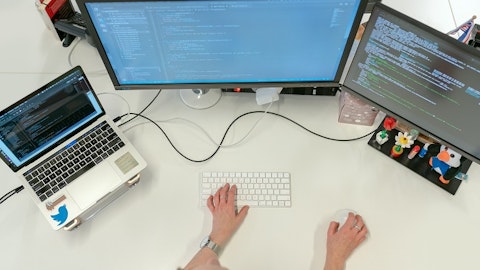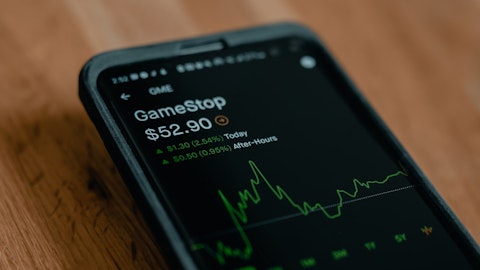Ruplu Bhattacharya : My first question is on the DMS segment. Mark, you’re seeing strong growth in automotive and healthcare, and you’ve taken up those two segments combined by $600 million for the full year. Like you said, the consumer-facing end markets in that segment are weaker, and you’re taking that down by 200 basis points. Net when I look at operating margin, it’s down 10 bps. So my question to you is if the consumer-facing end markets get weaker, can you talk us through your thoughts on margin risk in DMS? I mean, how — do you think margins can go lower in that segment? Or what offsets do you have — and typically, the reason I’m asking this is because typically one would think automotive and healthcare to be higher-margin end markets. So if you’re seeing a mix shift into that, what’s driving the 10 basis points lower? And how do you see risk to that if the consumer-facing markets go lower?
Mark Mondello : Ruplu, that’s a little bit of an open-ended question because I don’t know if you mean it this way, but I’ll answer it how I understand it, which is if the bottom falls out of all consumer-facing products, could the overall DMS margins go down further? Maybe. As we sit today, I think we’ve done a reasonably good job of for what we know, handicapping the back half of the year. And you — the way you stated it is largely correct. We’ve really kind of haircut and handicap any consumer-facing products. And again, the reciprocal of that is we feel good about industrial, automotive and healthcare. If you — as you’re putting your model together for the year, we just reported first quarter — we just gave you a hard guide on 2Q.
As I think about Q3 and Q4, our DMS margins, as you start putting numbers together and do your after calls and whatnot, I think what you’ll find is doing the math is to have our DMS business end up being at 5% or 5.1% margin. Whatever it ends up being, Q4 is going to end up being a pretty strong quarter. And I think that’s reflective of exactly what you said, which is some of the higher margins in auto and healthcare. I would also — why we’re on the topic of the year is, let’s not be — let’s be sure it’s not lost on us, the hard work and the complementary work that our EMS team is doing in terms of their business and margins for the year as well. When we went into 1Q, on the EMS side, we thought margins would be in the 4%, 4.1% range, that came in 4.3%.
If you take a look at our guide and do your math on that, you’ll see the strong margins returns in 2Q. And then if you think about the year on the EMS side, last year, I don’t remember the exact number, but EMS was 4.2%, 4.3%. Beginning of the year, we thought EMS would be — for the year, EMS would be around 4.4%, 4.5%. And I think EMS is going to come in closer to 4.6%, 4.7%. So again, let’s step back and just have an appreciation for the fact that the business is kind of an entire portfolio. And I say that respectfully I understand your question was around DMS. I hope that helps.
Ruplu Bhattacharya : For my second question, if I can ask, Mike, 4.8% operating margin total for the company. Can you help us quantify the inflation pass-through impact on that? I’m assuming like other EMS companies as component costs have gone up, you’re passing that through. I’m not sure if it’s a dollar for dollar, but if it is, then your revenue should be hurting — but sorry, your margin should be hurting because of that. And so what would that 4.8% have been if there was no inflation pass-through? And when we think about modeling margins, if we look back, the Slide 13 that you have, you’ve kind of shown us the last five years and how the margins have progressed since fiscal ’19, very strong performance. But I mean, as we model out going forward, what are the puts and takes here?
Like I mean you’re going to get a benefit as inflation goes down. That should help margins. But what are the other things that can drive margins? And any guidance you can give to — how do you think about what the target margins can be in the long term?
Mark Mondello : Ruplu, I’ll intercept that one for a minute. Wow, that was a lot. Let me bring you back to what I think was the first part of the question, which is, yes, you’re correct. In the first quarter, at an enterprise level, margins were 4.8%. I kind of think you answered your own question, which is 1Q of last year, margins were 4.7%. We thought that the first quarter would come in back in August, September, we were guiding and anticipating the margins for Q1 would be 4.8%. They came in right on top of the 4.8%. Again, I’ll bring you back to DMS margins were down about 20 basis points. EMS margins were up 20 basis points, again, indication of the size, scale, but again, the wonderful diversification we have. If we didn’t have good understandings with our customers in terms of equitable sharing when variable costs go up and down, we wouldn’t have delivered the 4.8%.
So I don’t say that to drive a concern. I say that much in an opposite way, which is the way we have our business set up, the way we have our customer relationship set up are very satisfactory to our leadership team. In terms of what else could have impacts on the overall margins for the year, it could be anything. On the downside, it could be that — the macro gets worse on the — so what do I worry about? Yes, the macro could collapse is that in the other, but then that instability will be there for everybody. What I don’t worry about is, I don’t worry about our team’s ability to execute. I don’t worry about our team in and of itself. I love the portfolio that we have. I don’t worry about the size of the market. I don’t worry about our ability to continue to gain share.
And maybe you wrap all that up I think our team, both at a factory level and above factory does a really, really nice job of controlling what we can control.
Ruplu Bhattacharya : Got it. I mean I really appreciate all those details. And wondering, maybe now if I can sneak one more quick one in. I know you’ve announced Kenny Wilson to be the new CEO effective May 1, and you’re going to take on more of a strategy, corporate development role. So can you just talk about from now until then, what are some of the handover activities you’re going to do? And should we think of any change in direction to the company? Or how should we think about this transition? Congrats again on the quarter.
Mark Mondello : Well, that’s an interesting question. I’ve been at this a long time, and I’d make this comment not directly around my relationship with Kenny. Whether my relationships with Kenny or Borges or Dastoor or McCoy or JJ or all the folks that you’ve met, we have a significantly tight-knit group. We’ve all been at this a long time. Sometimes that becomes problematic because it feels sometimes like we’ve complete each other’s sentences. So we’ve got to continue to challenge ourselves so we don’t have a group think. But Kenny has been with us a long time, so has the balance of the team. I don’t envision any of this being revolutionary. I think it will be evolutionary. We also added some other new leadership to the team recently with LaShawne and Kristine in legal.
So I think we’ll carry on. With that being said, as I continue to move more and more throughout the year into an active Chairman role, and you’re right, I’ll have my hands firmly involved with investors and our foundation and strategy and other stuff, I hope the team takes my 10 or 11 years and is disruptive in a positive sense. I think one of the things that this team has done over and over and over and over, and time and time again over 30 years is I think we’re proactive. I think we change when we need to change. We don’t change for the sake of changing. And I’d say, Kenny and some of the expanded leadership team is probably, in some sense, a little bit more edgy than I can be. And I think that’s a good thing. So I think there’ll be I think there’ll be some good changes.





